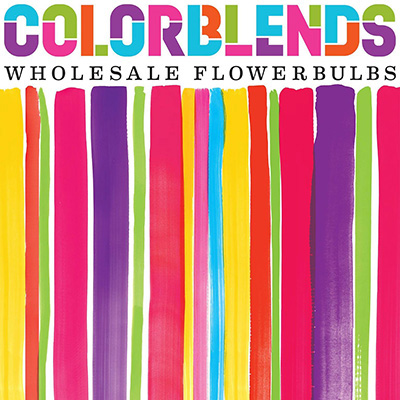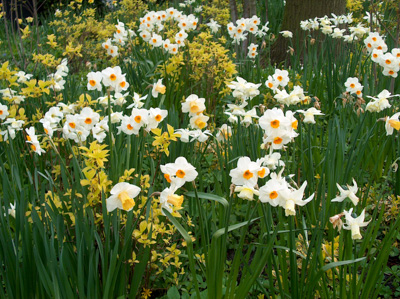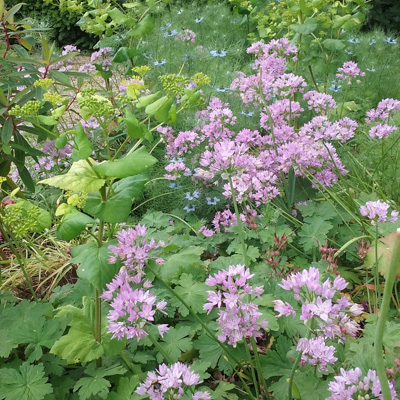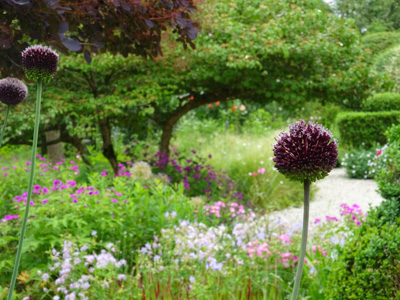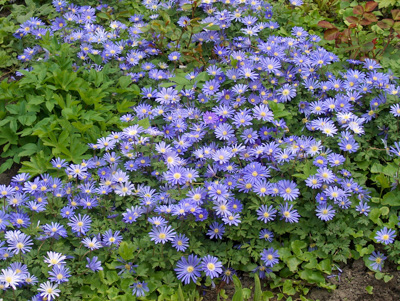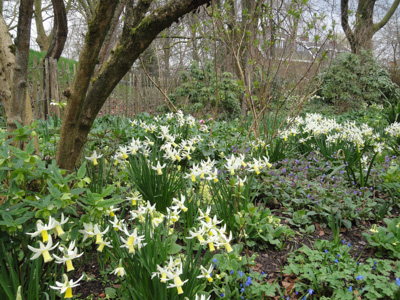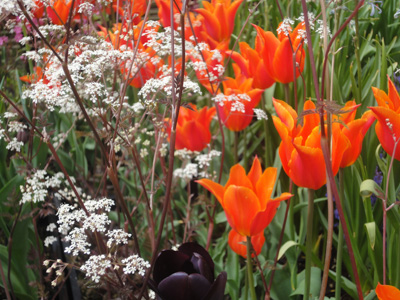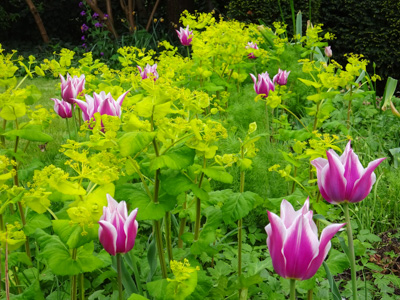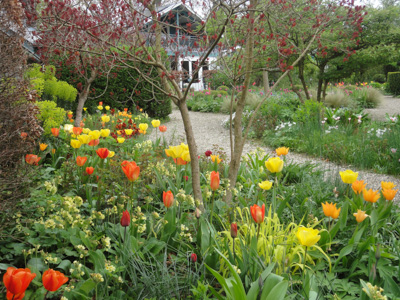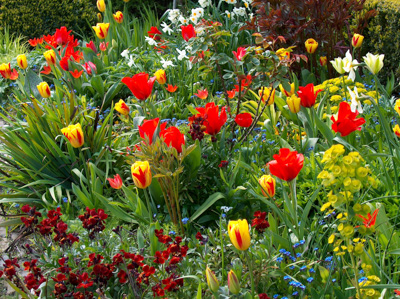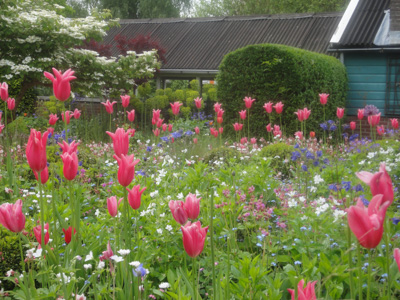Jacqueline van der Kloet
Design Notes
Daffodils with Dwarf Mock Orange
Combo: Philadelphus coronarius ‘Aureus’ (mock orange) and Narcissus ‘Thalia’, N. ‘Geranium’, N. Louise de Coligny’.
Location: The Keukenhof, Lisse, NL. Equivalent to USDA Zone 8b
Notes: In a woodland area with dappled sunlight, a mix of daffodils is planted among yellow Philadelphus coronarius ‘Aureus’ (mock orange). Three white daffodils are featured: midseason bloomer Narcissus ‘Thalia’ (with a cream-colored cup) and late-season bloomers N. ‘Geranium’ (orange cup) and N. ‘Louise de Coligny’ (apricot-colored cup). The idea here is subtle surprise—the plant mix brightens in a way that is more colorful than is expected. The same surprise returns in subsequent springs as the daffodils get enough sun to naturalize here. After bloom, the daffodil foliage dies back, masked by the mock orange. This combination will be a joy for many years.
Update a Basic Border
Combo: Basic perennial border with Geranium macrorrhizum ‘Spessert’ (white flowers touched with pink, consistently attractive foliage); Euphorbia griffithii ‘Fireglow’ (top left, red-tinged leaves, red stems and burnt-orange flowers); Hakonechloa macra (ornamental grass, forms loose cascading mounds). Upgraded with Allium unifolium (lavender-pink flowers); Smyrnium perfoliatum (on left, perfoliate alexander, biennial with lime-green flowers); Nigella damascena (love-in-a-mist, blue flowers). Not seen: Allium christophii and Senecio cineraria ‘Cirrus’ (dusty miller, annual, silver-gray foliage, mounded form).
Location: “De Theetuin,” Jacqueline’s garden in Weesp, NL. Equivalent to Seattle: USDA Zone 8a, AHS Heat Zone 2
Notes: A great “basic combination” gives you lots to play with and sets the stage for surprising plant partnerships. Here, a perfect basic combo of three long-performing perennials anchors a border photographed in early summer: Geranium macrorrhizum ‘Spessart’, Euphorbia griffithii ‘Fireglow’ (on the left) and the ornamental grass, Hakonechloa macra (not yet seen). This core threesome works “as is” or can be upgraded by adding annuals, biennials and spring-flowering bulbs, if you want to make more of it.
I tend to make more of things, so I’ve added multiple, naturalistic plant partners. Each contributes a light layer of color, texture and height to the mix. The combined effect is nicely complex to mimic how wild plants intertwine, multiply and spread. The plant partners I chose here are little work horses, all charmers worth considering for other early summer mixes:
- Allium unifolium, low growing, with lavender-pink flowers, blooms for 3 or more weeks in early summer, nice seed heads.
- Smyrnium perfoliatum, biennial, lime green flowers, attractive seed heads. One of my favorites for pairing with both late tulips and alliums. Be forewarned that it self-seeds profusely but is easily restrained by pulling (not a good choice where the seeds may stray).
- Love-in-a-mist, annual, lacy foliage, sky blue flowers, blooms in late spring/early summer for a month or two, attractive seed heads. Also self-seeds profusely, easy to pull.
- Dusty miller ‘Cirrus’, annual, silvery-gray foliage, brightens up different shades of greens in a bed.
- Allium christophii, silvery pink, airy umbels up to 10 inches across, begins flowering two weeks after Allium unifolium.
This same basic combo chugs along all summer with various plant partners. In fall, it presents fun twists. As the weather cools, the Geranium foliage turns bronze-red, the Euphorbia foliage turns deep red and yellow, and the ornamental grass takes on golden orange coloring that lasts well into early winter.
Alliums as Show Ponies
Combo: Foreground: Allium ‘Forelock’ (purple, stem initially hooks downward, then straightens); Imperata ‘Red Baron’ (Japanese blood grass, spikes) and Cotinus coggygria ‘Royal Purple’ (smokebush, dark-leaves at upper left). Also in front bed: Rosa ‘Lavender Dream’ (pale mauve, semi-double flowers); Artemisia ‘Valerie Finnis’; Allium roseum (blush pink). Not yet seen are later bloomers: phlox, lavender, Gaura, Veronica and, finally, in mid-fall, Amarine Belladiva (pink). Further back: Geranium ‘Patricia’ (magenta flower with black center, blooms May through August); Allium ‘Purple Sensation’ (seen as dried seed heads); and Viburnum plicatum ‘Watenabe’ (shrub with dark multi-stems). Beyond the viburnum is Stipa tenuissima (feather grass, low, transparent, sways nicely). Boxwoods play an evergreen role, throughout.
Location: “De Theetuin,” Jacqueline’s garden in Weesp, NL. Equivalent to Seattle: USDA Zone 8a, AHS Heat Zone 2
Notes: In late spring and early summer, alliums are the show ponies of this gray, pink and purple border. First up is 2 ½ -foot tall Allium ‘Purple Sensation’. Next, 5-foot-tall Allium ‘Forelock’ prances in (with this scene-stealer, one bulb per square yard is plenty). I like the contrast in height and texture between the tubular stems and dense flower heads of the tall alliums and the cloud-like flowers and foliage of the shorter perennials. After the purple umbels fade, their long-lasting seed heads stay attractive and upright. A third allium, fragrant, 16-inch tall Allium roseum, contributes a very different look with loose clusters of soft-pink, star-shaped flowers. Alliums perennialize in sunny spots with well-drained soil. Every five years or so, I add a few more bulbs of the purple varieties in fall. There’s no need to augment the Allium roseum – it multiples in colonies and comes back reliably, year after year.
This scene closes out the spring bulb flower show for this border. From late winter into early summer, fresh waves of bulb flowers come and go here, progressing from crocuses, Anemone blanda (windflowers) and Scilla (blue squills) to daffodils, then tulips and early alliums. As each wave fades, emerging perennials hide the declining bulb foliage.
Anemone blanda and Astrantia
Combo: Anemone blanda ‘Blue Shades’ with Astrantia.
Location: Harlingen (Friesland), NL, Equivalent to USDA Zone 8b
Notes: Low-growing Anemone blanda is useful for adding a secondary layer of color in the early-mid spring garden. It thrives in full sun or dappled shade and will naturalize when planted in a spot that it likes. I love the contrast between its bright green foliage and sky-blue flowers.
Astrantia makes a great companion for early and midseason bulbs. It comes up early and fills out fairly slowly so that by mid-late spring it’s still low, just the right height to form a backdrop of green. It has nice, but not large, leaves that don’t compete with blooming bulbs. Later, as the Astrantia gains size, it hides the yellowing foliage of the bulb plants after bloom. In this way, the Astrantia provides ornamental value in spring as well as in summer when its old-fashioned, pincushion flowers bloom.
Naturalized Woodland Planting
Combo: Heirloom narcissi in softer shades of white and yellow (all one foot tall or less). Companion plants include: bulb flower Scilla siberica ‘Spring Beauty’ and perennials: Helleborus orientalis, Corydalis solida, Primula elatior (true oxlip), Pulmonaria saccharata ‘Mrs. Moon’, Arum, Anemone japonica, Rodgersia and Geranium macrorrhizum.
Location: “De Theetuin,” Jacqueline’s garden in Weesp, NL. Equivalent to Seattle: USDA Zone 8a, AHS Heat Zone 2
Notes: This exciting but subdued combination brightens the dappled shade of a woodland area. My focus is on the various colors, textures, and heights, as well as the shapes of the flowers and foliage. A relaxed, elfin mood prevails. The colors are soft. Cream, yellow and blue dominate within a sea of greens. The greenish seed heads of winter-flowering hellebores add a nice, dignified touch.
The daffodils will naturalize to provide extended bloom, year after year. The Scilla, too, is naturalizing and, over time, will create carpets of brilliant blue that will bloom in sync with the daffodils in spring. The Pulmonaria and Geranium also gain size. In the same area, where it is a bit more shaded and moist, I’ve placed Arum, Anemone japonica, Rodgersia and Geranium macrorrhizum. The Primula elatior is self-seeding here. Where it becomes overly enthusiastic, it’s easy to pull out.
The scene changes constantly in spring, over the course of six to eight weeks. As the bulb flowers fade, their foliage dies back naturally. By then, the perennials have taken center stage.
Layers of Contrast
Combo: Orange Tulipa ‘Ballerina’ and deep maroon T. ‘Queen of Night’—with dark-stemmed, white-flowered Anthriscus sylvestris ‘Ravenswing’, a hybrid form of common cow parsley.
Invasive alert: Anthriscus sylvestris is an invasive plant in parts of North America. In the U.S. ‘Ravenswing’ is primarily grown by seed. Be aware that it can run rampant where happy, unless deadheaded before going to seed. In the Netherlands, ‘Ravenswing’ is widely available, pre-grown in nursery pots.
Location: Beervelde, Belgium. Equivalent to USDA Zone 8b
Notes: Contrast is often bold but it does not need to be. Sometimes it is even more impressive when contrast is subtle and feminine. Layers of contrast work together here to achieve a smashing effect. First, there’s the contrast between the large tulip flowers and the small, delicate flowers and foliage of the Anthriscus. Additionally the rich orange plays off the dark brownish purple, while the lacy white connects it all like a veil.
Tulips with Smyrnium and Nigella
Combo: Lily-flowered Tulipa ‘Ballade’, Smyrnium perfoliatum (yellow alexander), Nigella damascene (love in a mist) and Geranium macrorrhizum (cranesbill).
Invasive alert: Smyrnium and Nigella are self-seeders that can become invasive in some areas. Both are easy to pull.
Location: Hulst (Zeeland). NL. Equivalent to USDA Zone 8b
Notes: When I encountered this simple border, it was rather boring in spring. That changed when Smyrnium perfoliatum (yellow alexander) and Nigella damascena (love in a mist) popped up. They’d self-seeded among existing Geranium macrorrhizum (perennial geranium). The geranium is still there as a ground cover for later in the season.
This was a spontaneous green-on-green combination that I liked. I invigorated the mix with splashes of bright magenta by adding lily-flowered Tulipa ‘Ballade’. There’s great contrast between the the large bright tulips, the dill-like foliage of Nigella and the golden foliage and flowers of Smyrnium.
With little investment of time or money, this very simple border is attractive in spring as well as summer. The combination is magic for nearly three weeks. By late spring, the tulips fade. When the Smyrnium turns golden and papery, it’s time to pull it out—the show is over. Meanwhile, the Nigella begins to bloom. If reseeded, it keeps going all summer, producing new foliage and seed heads. The Geranium macrorrhizum blooms late spring through midsummer, with flowers in nearly the same color of magenta.
Color Sets the Tone
Combo: The series kicks off with yellow crocuses, followed by early-blooming yellow daffodils (Narcissus ‘Tête-à-Tête’). Then come the tulips, including types that flower in early, mid and late seasons. Among them are: Tulipa praestans ‘Shogun’, T. ‘Yellow Purissima’, T. Orange Emperor’, T. ‘Jewel of Spring’, T. ‘Flashback’ and T. Ballerina’.
The companion plants include some of my favorities: Primula elatior (pale-yellow flowers, a self-seeder); Milium effusum ‘Aureum’ (an early ornamental grass, bright yellow, a self-seeder); Erysimum (wallflower); Euphorbia characias wulffenii; and various Geranium, now with foliage only visible, the flowers will come later in summer.
Location: “De Theetuin,” Jacqueline’s garden in Weesp, NL. Equivalent to Seattle: USDA Zone 8a, AHS Heat Zone 2
Notes: The perennial base of this border in spring has yellow, orange and deep-red flowers and/or foliage and so do the spring-flowering bulbs. The bulbs bloom sequentially, with an ongoing show of yellow, orange and deep-red flowers, always with changing heights, structures and textures. After bloom, the declining bulb foliage will disappear between the perennials.
For a planting of this sort, I might add bulbs in quantities like these, per square yard: 8 long-stemmed tulip and/or 8 tall narcissus bulbs; 12 botanical tulip bulbs and/or 12 small narcissi bulbs; plus 20 scilla; 20 crocus; and 15 Anemone blanda bulbs.
A Tapestry of Spring Color
Combo: Seen here are three late-flowering daffodils plus four mid- to mid-late-blooming tulips (including greigii, species, Darwin hybrid and viridiflora types). Companion plants include: Euphorbia, wall flowers and Mysotis (forget-me-nots). Early-summer peonies and roses will join in.
Location: Oostkapelle (Zeeland), NL. Equivalent to USDA Zone 9a
Notes: In my client’s garden, we are playing with the colors red, yellow and orange in both spring and summer. Here tulips and daffodils add light splashes of bold color to a green backdrop laced with deep red (red wall flowers, red-leafed peonies) and greenish yellow (Euphorbia). The piquant touch of brilliant blue is Myosotis (forget-me-nots), planted lightly here and there.
Later in the season, a lovely interplay develops between not-yet-budded-out summer companions: yellow Rosa ‘Golden Wings’ (center), yellow Coreopsis verticillata ‘Moonbeam’ (not yet visible) and the orange-yellow Crocosmia ‘George Davison’ (the clumped upright narrow leaves on the left).
Pink Lily-Flowered Tulips
Combo: two pink tulips, Tulipa ‘Jacqueline’ and T. Mariette’.
Location: “De Theetuin,” Jacqueline’s garden in Weesp, NL. Equivalent to Seattle: USDA Zone 8a, AHS Heat Zone 2
Notes: In late spring, two pink, lily-flowered tulips, ‘Jacqueline’ (not named for me) and ‘Mariette’, take the leading role around the edge of this part of my garden. They are almost identical but differ in height. That gentle difference softens the overall effect.
Beneath the tulips, you see an understory of Geranium macrorrhizum ‘Spessart’ (not yet in bloom), Geranium sylvaticum ‘Album’ (white), Myosotis (forget-me-not, some blue, some pink), Aquilegia vulgaris (not yet in bloom), and Stipa tenuissima (Mexican feather grass).
As spring moves into early summer, the scene changes. A more structural feel is evident. The color becomes subtler, predominantly green. Now, the graceful movement of silvery-green ornamental grass (Stipa tenuissima) is what draws one’s eye. The clumps of soft grass are set off by late-emerging Euphorbia seguieriana niciciana (Siberian spurge). This semi-evergreen beauty has upward-facing clusters of round, lime-green florets, backed by dark-red stems and narrow blue-green foliage. Its complexity is brilliant in combination with massed plants with simple, vertical lines such as grasses, alliums and lavenders.
My home and garden are in the small town of Weesp on the River Vecht, nine miles from Amsterdam’s center city. My garden benefits from fairly temperate conditions, with a winter that’s cool but not freezing and a summer that is, increasingly, drier.
Given good sun and good soil, certain spring bulbs naturalize here. Even some tulips come back to rebloom, often for several years, sometimes more. When we started the garden it had heavy clay. So I added sand and compost to improve the soil drainage. Each spring when the bulb foliage noses through, I add compost to the soil surface as an organic slow-release fertilizer. This provides steady nutrition through late spring, when energy is needed to make a new flowering bulb for next year. After bloom, I deadhead spent flowers, with a quick snip or a snap right under the flower head. I leave everything else as is—stems and leaves are left to wither fully, untouched. Plus, over summer, unless adjacent perennials are fainting, I do not do any supplementary watering. No sprinklers. Most dormant bulbs want to be dry. That’s all the magic I put in.
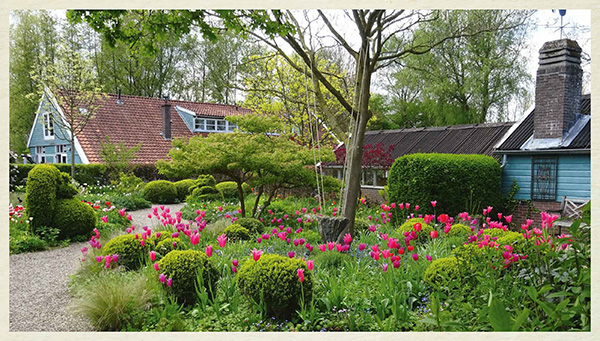
Excerpt from Jacqueline’s book, A Year in My Garden:
I leave all bulbs in the ground after they have flowered and then hope that they will flower again for many years. That method works well for several species, but tulips are always a risk. That is because they are very particular: the right habitat, not too wet and not too dry, the right amount of light and various other requirements.
Experience has taught me that the strongest tulips – which are likely to flower for several years – come from the groups of Darwin hybrids, lily-flowering tulips, a few late tulips and double late tulips. But there are a number of parrot tulips, including ‘Black Parrot’, ‘Flaming Parrot’ and ‘Professor Rontgen’, which will return several years in succession too.”
van der Kloet, Jacqueline, A Year in My Garden, Amsterdam, Hélène Lesger Books, © 2019
